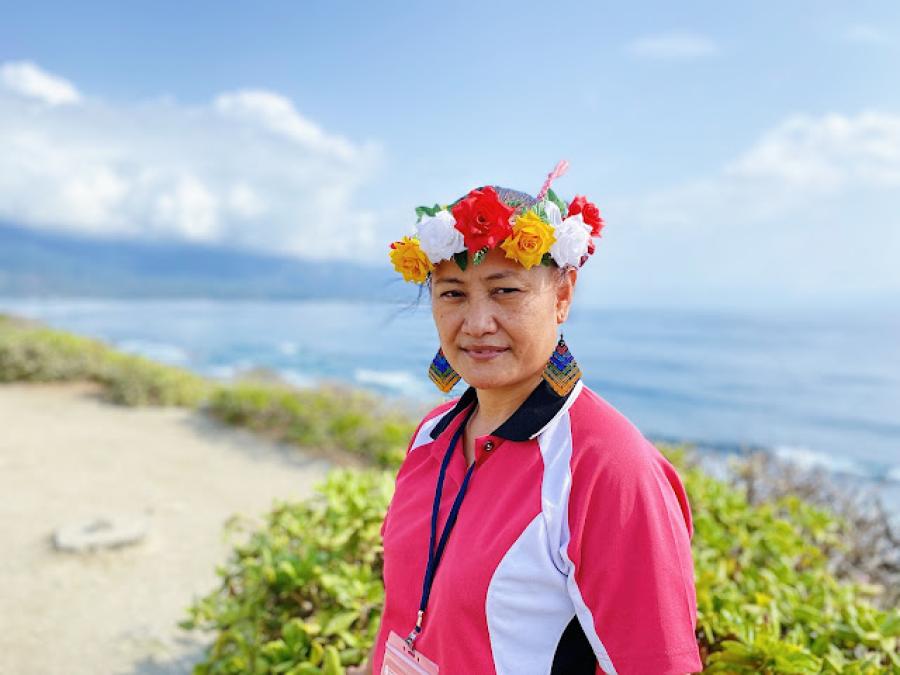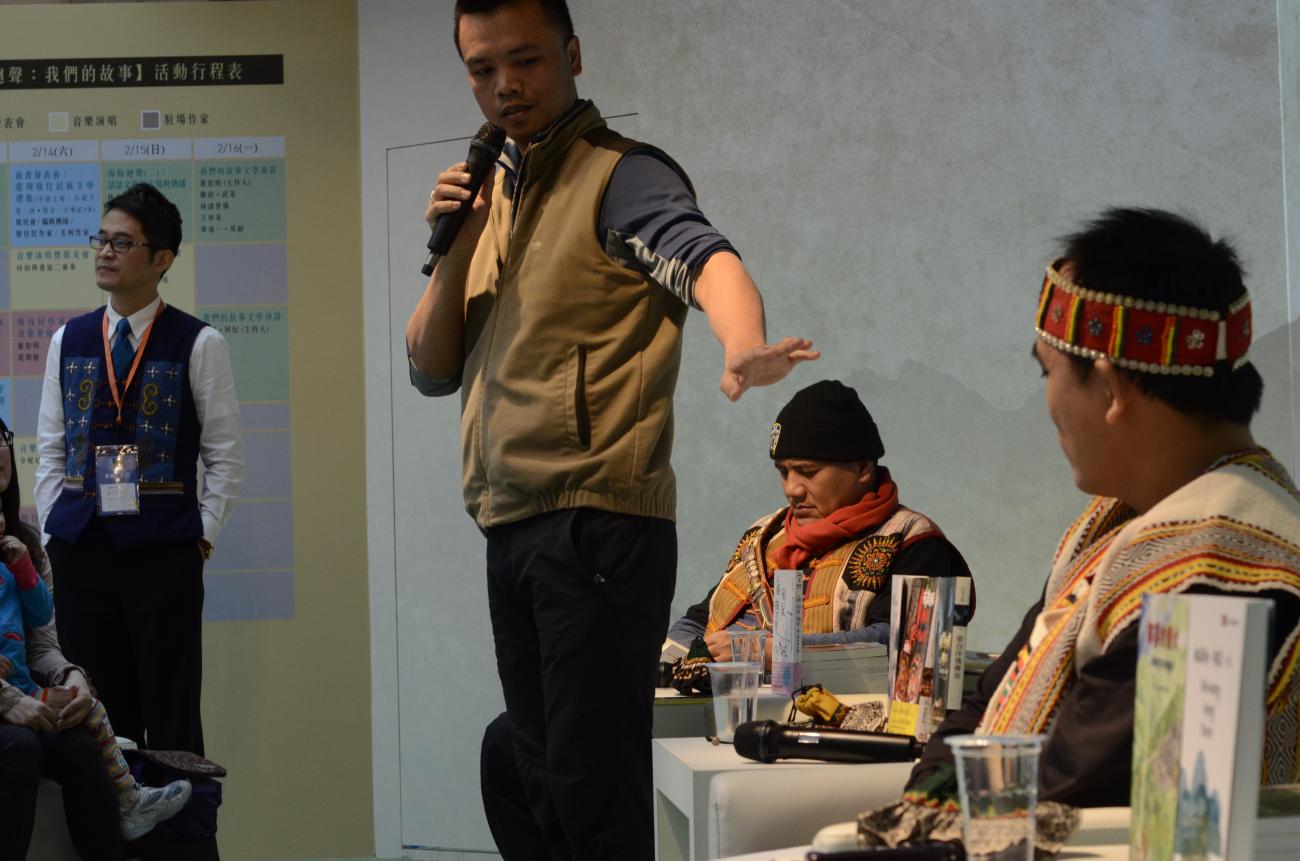
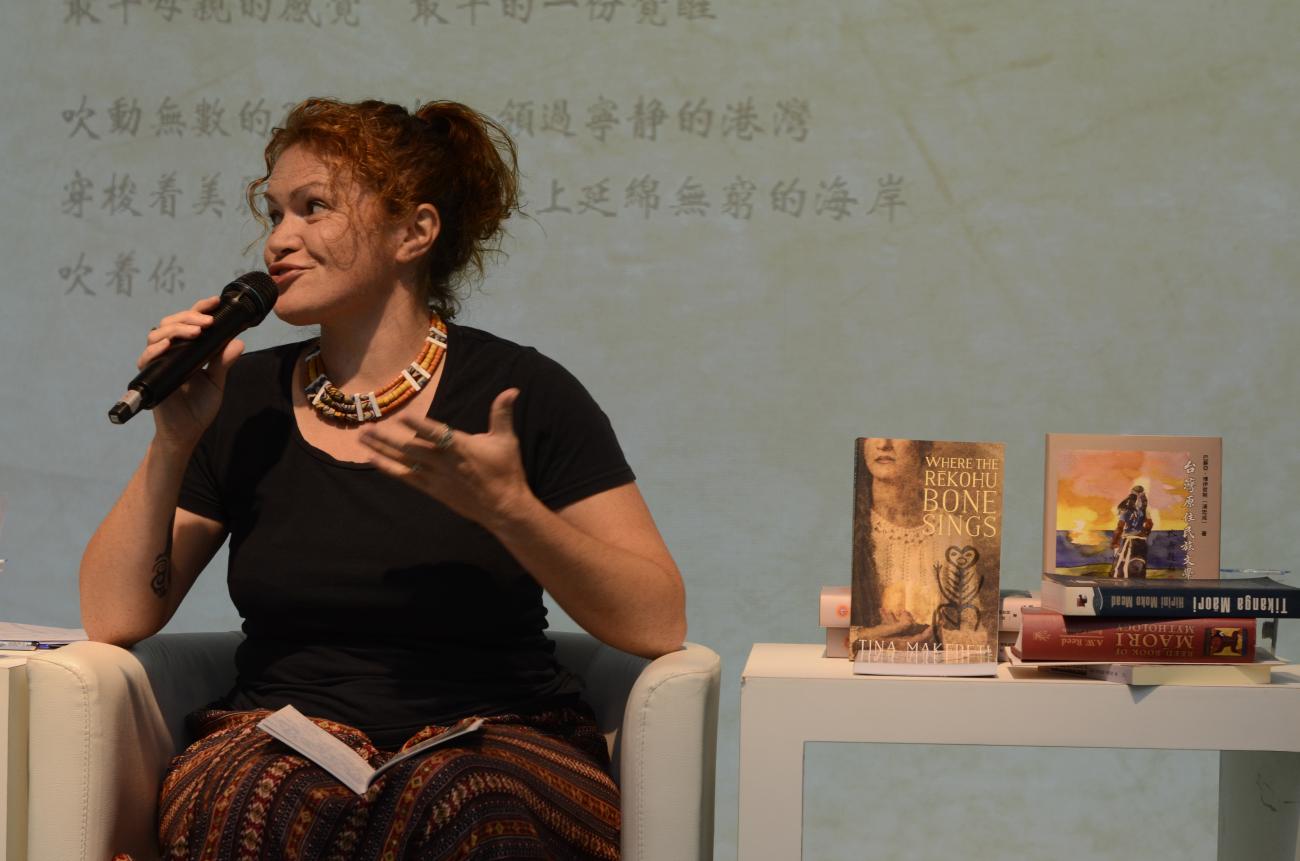
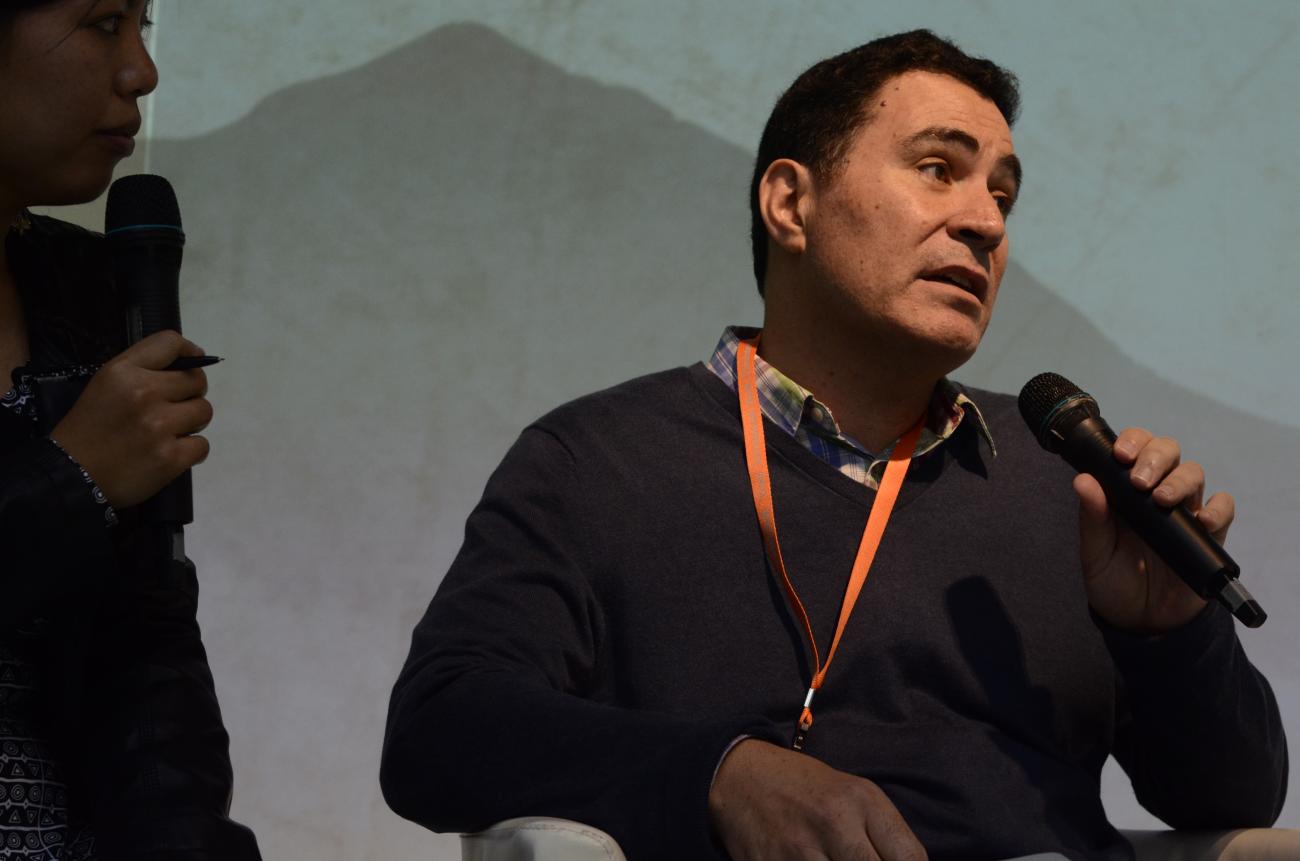
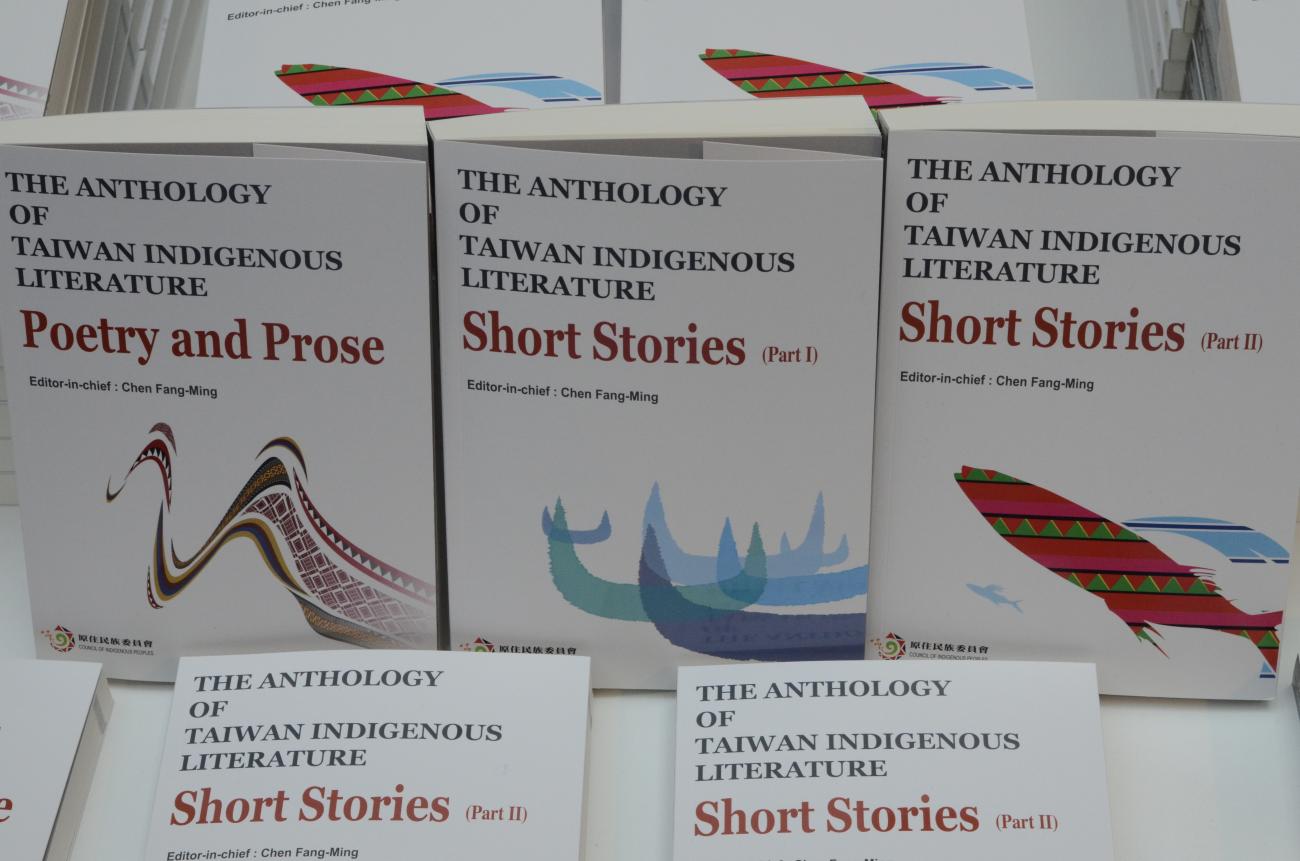
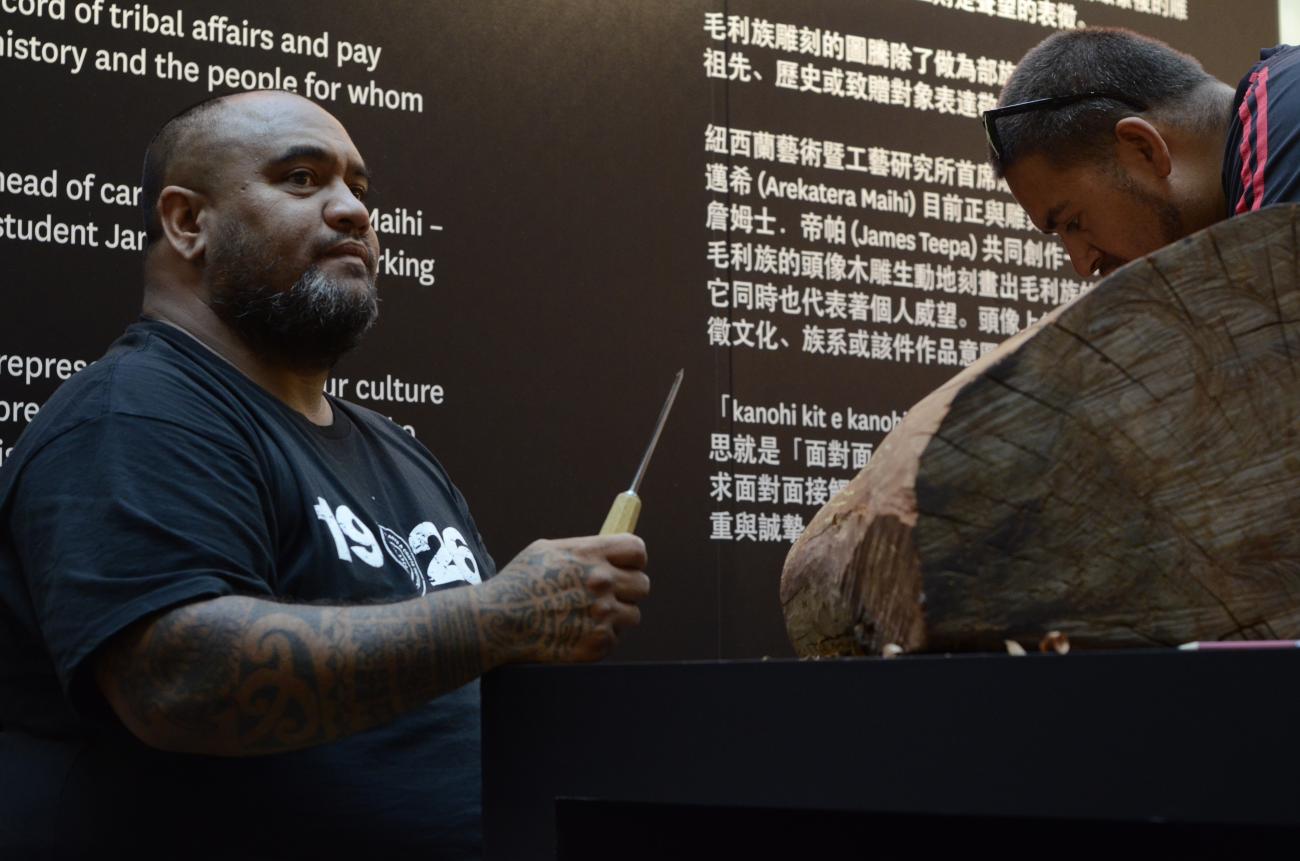
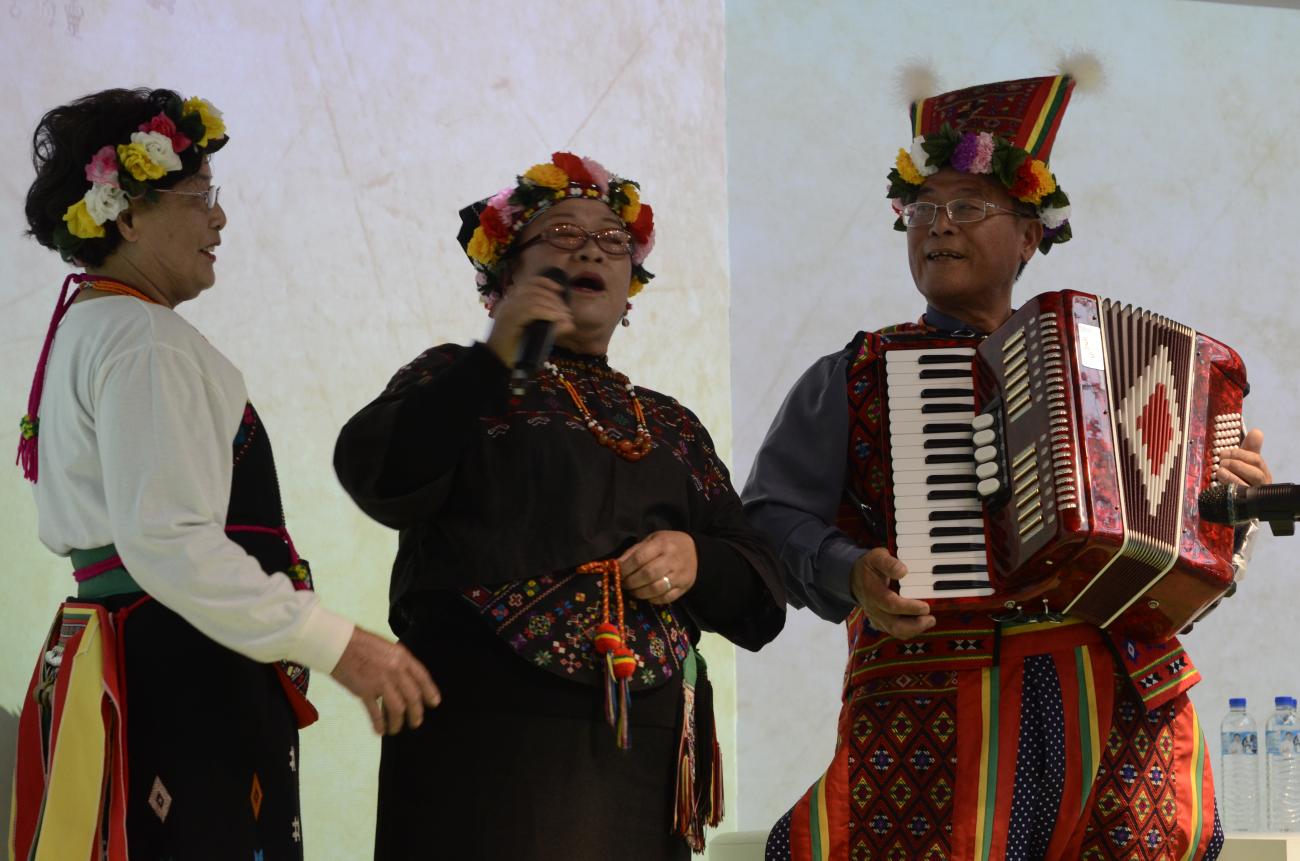
By Glenn Smith
Success in book publishing is an indicator of the vitality of an ethnic minority within the dominant culture, and at the 2015 Taipei International Book Exhibition (TIBE), held from February 11 through 16, Taiwan's Indigenous Peoples demonstrated their mandate to perpetuate their culture despite a century of rule by outsiders. Also evident at TIBE was the growing linkage between Taiwan's Indigenous People and their Austronesian cousins scattered across the Pacific Basin. This year's guest of honor country at TIBE was New Zealand, and a 70-strong contingent of writers, illustrators and publishers came to Taipei for the show. New Zealand proudly displayed its Maori heritage throughout the event under the theme “Open Hearts, Open Minds, Open Books.”
Taiwan's Council for Indigenous Peoples (CIP) took full advantage of this opportunity. Located immediately adjacent to that of New Zealand, the CIP's Taiwan Indigenous Literature Pavilion was themed “Echoes from the Island in the Ocean: Our Stories.” Throughout the six-day event, there was a lively, on-going exchange between Maori and Taiwan Indigenous writers in panel discussions and workshops, and a series of performances by guest artists and performers.
The Anthology of Taiwan Indigenous Literature debuts at TIBE
Then, of course, there were books. More than 500 works by Taiwan's Indigenous authors were on display at the CIP pavilion, and the occasion was used to celebrate the debut of the four-volume The Anthology of Taiwan Indigenous Literature, featuring works originally written primarily in Mandarin for Taiwan readers, but translated into English to reach a wider audience.
The English-language anthology is a collaboration of the Taiwan Indigenous Cultural Industry Development Association and the Taiwan Indigenous Voice Bimonthly Magazine edited under Prof. Chen Fang-Ming (陳芳明), Graduate Institute of Taiwanese Literature, National Chengchi University (NCCU).
But the anthology project and its timing was the brainchild of Sun Ta-Chuan ( 孫大川 ), also known by his Puyuma name, Paelabang Danapang, who in recent years has held national-level political appointments; for example, he is currently vice president of the ROC Control Yuan and a former National Policy Advisor to President Ma Ying-jeou. These posts came after a stint as CIP Minister that followed a long career as a literature professor at several Taiwan universities and a youthful beginning as an Indigenous writer and founder of Shanhai Culture Bimonthly.
Sun was present throughout TIBE, and moderated several of the panel discussions between Taiwan Indigenous and Maori authors held at the CIP pavilion. On the morning of Friday, February 13, Sun was seated with Pasuya Poiconu (Mandarin name, 浦忠成), Director, Taiwan's National Museum of Prehistory, and visiting Maori authors, poet Robert Sullivan and novelist Tina Makereti. When the session ended, Sun was cornered for a brief interview. “Taiwan now has 50 Indigenous writers producing literary work,” Sun told Cultural Survival, “but it wasn't until the early 1990s that a literary movement emerged. The real beginning – that is to say the point at which we had our own magazine -- was in 1993 with the launch of Shanhai Culture Bimonthly.” In Mandarin, shanhai means 'mountain and sea', a reference to the island's Austronesian people. “That was when our writers finally had a platform from which to express themselves.”
Mandarin as lingua franca for Taiwan authors
The reasons for this late take-off are many, and to understand why, a brief history lesson is in order. Today the Austronesians of Taiwan are a minority people in what is their homeland, numbering half a million, roughly 2 percent of the island's population. Sixteen tribes, each with their own languages, are officially recognized. Their roots extend back many millennia, and until four centuries ago, they were in full possession of the island.
These Austronesian Peoples had rich oral literary traditions before contact with the outside world. Then came contact with the West – Spain (1623) and Holland (1626) – and wave after wave of Han immigrants from China who forced tribes of the island's fertile low-lying western shore into highlands occupied by other tribal nations.
Next came the Japanese, in 1895, and Taiwan, then known as Formosa, became a Japanese colony. Half a century later, the reins of power shifted again in 1945 with the arrival of Generalissimo Chiang Kai-shek and the Chinese Nationalists (KMT).
Both the Japanese and the Chinese Nationalists instituted monolingual assimilation policies. Under the thumb of these rulers, the Austronesians were a people to be studied, and prior to the literary movement of the past few decades, few 'native' writers emerged. Instead literary efforts focused on documenting myths and customs.
Language suppression was particularly intense during the first decades of KMT rule. From 1945 onwards, all media – national and local – were required to use Mandarin exclusively. Beginning in the 1950s, Christian missionaries devised phonetic scripts for Austronesian languages, but these were seldom used for written communication outside of the church. To publish in a 'native' tongue was seditious and could land the author in a jail.
Yet new possibilities for expression appeared with the lifting of martial law in 1987. But by then Mandarin, by default, was the lingua franca of Taiwan's Indigenous Peoples, and today nearly all literary works – except for bilingual editions – are written in Mandarin.
The Post-Shanhai Literary Boom
Sun was one the island's Indigenous writers when the KMT began loosening its grip on Taiwan's media in the 1980s. “Before the nineties, there were only four or five of us,” recalled Sun. These new writers identified themselves as Indigenous, and their outlook was political. “Our writing criticized the neglect that Han society had shown our people. We took our pain and put it into writing... our language was gone, our land was gone, our customs were gone,” said Sun. “I wrote an essay, 'Twilight', and I chose that title to describe the calamity that had befallen us. We were becoming a 'twilight' culture. 'Twilight' appeared in the China Times [one of two major KMT controlled dailies] in 1988 or 1989.”
These early writers were primarily social critics but soon authors of fiction joined their ranks. Sun cited Topas Tamapima (Mandarin name, 田雅各) as an example. “Topas began a bit earlier than the rest of us,” said Sun. “Topas was a doctor, of the Bunun tribe, and his short story 'The Last Hunter' was published in 1987.” The literary merit of 'The Last Hunter' earned Topas recognition by Taiwan's Han readership – a first for an Indigenous author.
In “The Last Hunter” and in the fictional works that followed it, Indigenous writers examined their tribal cultures and re-constructed them," explained Sun. "In Topas' story, the main character, Biyaze, kills a muntjac, only to have it confiscated by a Han police officer as he is bringing his bounty home. “To earlier generations of Bunun, being a hunter earned one the ultimate in respect,” said Sun, “but today being a hunter is seen as a useless pursuit. You will be arrested by the police. 'What are you hunting for?' your wife will ask you. 'Why don't you go earn some money?'”
Traditional cultural values -- and how they were changing -- were a major concern for Indigenous writers. More recently, there was been a shift toward magical realism, with stories set amid a contemporary village but intertwined with elements of now disappearing myths and legends.
TIBE: Lifok Oteng and Kowan Talall
Included in the four-volume anthology on display at the CIP pavilion was a chronicle of significant events, and it was loaded with photographs of key writers. That made them easy to spot at TIBE. Two writers in attendance were authors whose work actually pre-dated the outpouring of writing of post-Shanhai authors that Sun had summarized. One was 84-year old Lifok 'Oteng (Mandarin name, 黃貴潮), an 'Amis who began a diary on March 5, 1951, recording life and tribal affairs in his village near Taitung.
Lifok is considered a living national treasure, and last summer he was the first Indigenous person to receive an honorary Ph.D. Lifok is also an acclaimed 'Amis musician, among other Indigenous cultural pursuits too numerous to list. “You know I'm a photographer, too,” said Lifok when asked for permission to take his photograph. His diary is now in its sixth decade, written first in Japanese, then in Mandarin, with a mix of Japanese katakana, Chinese phonetic symbols and Western romanization to record events in tribal language.
Excerpts from Lifok's dairy were not published until 1996, and since then several volumes have been made available, and were prominently displayed at TIBE. The other was Kowan Talall (Mandarin name, 陳英雄, romanized as Chen Ying-hsiung), the first Indigenous writer to break into Taiwan's world of print. Now, 74 years-old, Kowan was a 20-year-old police officer in Taiwan's southeastern city of Taitung when his first article appeared on April 15, 1962 in the United Daily News, the other major KMT daily newspaper of the time. His essay was titled, “Mountain Village”, said Kowan, who is Paiwan. “It was a description of the scenery in an 'Amis village.” His byline was 陳英雄, a name he would use throughout his literary career. “Readers didn't know that I was an Indigenous writer,” he explained. Kowan produced a steady stream of work through the sixties and into the seventies. His writing documented many facets of Indigenous life but was strictly apolitical, as was everything published by anyone – Han or Indigenous – in Taiwan at the time. In the mid-seventies, he won several literary prizes. “There wasn't another Indigenous writer in Taiwan for twenty years,” said Kowan. The next published work by Indigenous writers would not appear until the 1983 launch of the short-lived High Mountain Youth (高山青) magazine by National Taiwan University students, Iban Yukan and Icyang Parod. At TIBE, Kowan was carrying a four-inch thick handwritten manuscript about his mother, who was a Paiwan sorceress. Asked if he would use his Paiwan name as author, Kowan replied, “No, people still know me by my Chinese name, 陳英雄.”
TIBE: Masao, Sakinu and Nequo
So much has changed since Kowan was the lone, ethnically 'closeted' Indigenous writer and the subsequent opening of the floodgates of expression and identity on Taiwan after the lifting of martial law in 1987. During the 1980s, Taiwan was in the midst of an export-driven boom, and around the island young Indigenous People had left their villages to work in Taipei, Kaohsiung and other cities. But economy slowed in the mid-1990s. By the year 2000, some who had left were returning to their villages. “This was an important change,” said Sakinu Ahronglong (Mandarin pen name, 亞榮隆.撒可努同). “Lots of us returned home, and we were looking for a new road.”
Writer and filmmaker Sakinu, a Paiwan, was a guest speaker at TIBE, as were the Bunun author Neqou Soqluman (Mandarin pen name, 乜寇.索克魯曼) and Atayal writer Masao Aki (Mandarin pen name, 馬紹‧阿紀). Typical of their generation, these authors are also Indigenous advocates. Both Sakinu and Nequo, who has a master's degree in ecology, have founded 'hunter' schools, as they are known locally, which teach Indigenous outdoor skills, but more importantly emphasize traditional values. Masao is a media professor at Shih Hsin University, and was formerly chief director of Taiwan Indigenous Television (TiTV) and was chairman of World Indigenous Television Broadcasters Network (WITBN) in 2010.
During TIBE, Cultural Survival asked them: How will having an English anthology of their work benefit the Indigenous people of Taiwan? Their initial replies offered the obvious: More readers in more places. Pushed to elaborate, Masao said, “When something can be read in English the whole world will see it,” he said. “Through translation, readers can explore the life stories of all of the cultures of Taiwan's many tribes.”
To be understood, Masao's comment needs to be inverted. Have the life stories of Indigenous people on Taiwan been told in the island's or the world's mass media? By and large, the answer is 'no'. For decades, the Taiwan press has treated them as 'local color' or living outliers of some distant past. To have life stories of Indigenous people facing real problems – even though presented through fiction -- is a great leap forward. Sakinu has visited the U.S. several times for the debuts of his films, Mountain Pig, Flying Fox, Sakinu and The Sage Hunter, the latter based on a semi-autobiographical novel he wrote about a tribal policeman leading a protest against the construction of a highway on ancestral burial grounds. He was surprised that Americans were not aware of Indigenous People in Taiwan. “While in L.A., I visited several Indian tribes, and even they didn't know there were Indigenous People in Taiwan,” he said. He hoped that the anthology would reach the Indigenous People of North America, Australia and New Zealand, all of which have English as a language. “If they read our work, they will think, 'Oh, my God, we are all in this together.'”
Taiwan has a vibrant publishing industry – as is readily apparent from a walk around TIBE -- and locally there is a hunger for popular foreign titles and they are quickly translated into Mandarin. But global Indigenous writing is a glaring blind spot. “We are curious about the Indigenous literature of other peoples around the world,” said Nequo, “but very little of it is translated into Mandarin.”
In contrast, Nequo, or any Taiwan writer who reads Mandarin, can easily follow Western literary trends abroad. Referring to his first book, Palisia Tongku Saveq [Rough translation: Talking about what is seen from the top of Jade Mountain] published in 2008, Nequo said, “There's lots of magic in it, and it belongs to the genre of fantasy literature.” Palisia Tongku Saveq is being translated into English by John Balcom, of the Monterrey Institute of International Studies, described it as Bunun myth and legend meets Lord of the Rings.
Sun: A ready-made feast for Pacific readers
Sun, during his long career as writer, editor and Indigenous advocate, has been involved with the compilation of many earlier Taiwan Indigenous anthologies, mostly in Mandarin for Chinese readers in Taiwan. In Japan, beginning in the 1990s scholars translated several volumes of Taiwan Indigenous writing, while in the West, John and Yingtshi Balcom translated and compiled Indigenous Writers of Taiwan in 2005.
Explaining the rationale for the launch of The Anthology of Taiwan Indigenous Literature presented at TIBE, Sun said, “This is a gift, a ready-made feast that everyone can eat, that everyone can experience for themselves.” Having works available in languages other than Mandarin increases their prestige, even for Chinese readers at home. “I hope that it will prompt our Han friends – both private citizens and government officials – to reconsider their attitudes toward the Indigenous People on Taiwan,” said Sun. “I also hope it will help our Indigenous youth to understand the extreme crisis that their people face and encourage them to do something about it.”
To confront a crisis, awareness is the first step. The Japanese, for example, have a better than average – internationally speaking – understanding of Indigenous culture in Taiwan due to their history as a colonial power on the island and due to reporting of Taiwan's Indigenous affairs in their mainstream media. Sun said at least 15 volumes of Taiwan Indigenous writing have been published in Japan, but he cautions that he is not referring to the enormous amount of anthropological work published in scholarly journals every year. “Everyday readers have no interest in scholarly writings,” said Sun. “Japanese-language editions of Indigenous literature are not best-sellers in Japan. But, if through translation, an interesting literary story is presented that is easy for the average person, especially the young, to grasp and enjoy, then there is communication.”
Having a literary presence in the foreign popular press is a form of grassroots diplomacy. “In the case of Japan, we see a clear response,” said Sun. “More and more young Japanese travelers are coming to our villages, and it is because they have read about us at home. They know our tribal festivals and cultural customs. An entire village from Hokkaido came for a visit, and they invited their Taiwan hosts to visit them in Japan.”
Speaking again of “The Anthology of Taiwan Indigenous Literature” presented at TIBE, Sun said, “In recent years, there has been a growing cooperation between Taiwan and New Zealand, and not only is English spoken there, but the Maori people also belong to Austronesia. The Maori can understand our history and our feelings. I believe the anthology will find readers across the Pacific region – in New Zealand and Australia, and Hawaii – so we plan more English translations. That is our strategy,” Sun concluded. “As for America and Canada, well, those places are a bit farther away and that is an area where Cultural Survival Quarterly and magazines like it can help us.”
-- Glenn Smith is a contributing writer for Cultural Survival, living in Taiwan.
